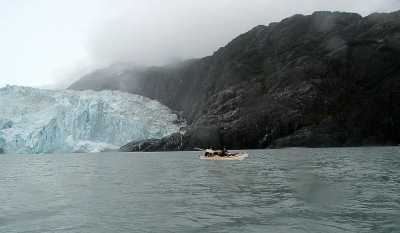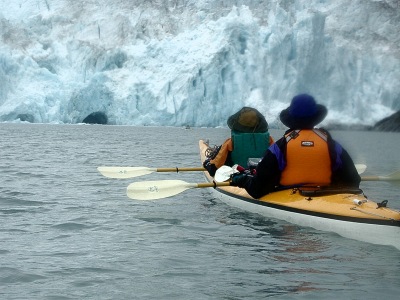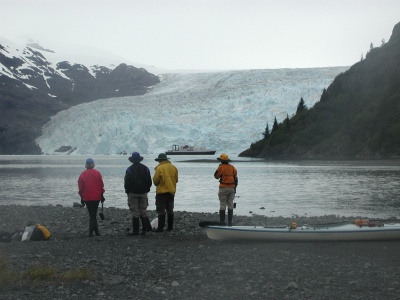Glacial Thunder: Sea Kayaking
in Prince William Sound 2001
Facing the glacier
Friday, August 17
 We awoke to intermittent mist, and some fog. I decided that we could use some additional protection from the elements, so I used our other poles, and set up the flat tarp as a porch for our three-sided tarp, creating a nice complex under which to cook and eat. Nobody was moving very quickly, and it was a great day not to have to pack up and move camp. Our plan was to take a day trip and take a good close look at the face of the Chenega Glacier, and then beach our kayaks near the mouth of a river that flows out of the Princeton Glacier, in order to let our offical fisherman get a last shot at salmon. We pulled out about 10:30, and it did not take us very long to get to the point where we wanted to view the glacier. I could feel the apprehension building up in Susie's voice again. It seemed like she needed a bigger safety margin than anyone else. Maybe it was just the fact that it was cloudy, rainy, and the wind coming off the glacier was mixing with the ambient winds, to make for a mixed up situation. We came to within a kilometer or so of the face of Chenega, Susie wanting for some reason, to be close to the rocky cliffs that mark the right (north) side of the fjord. I tried to snap a few photos, but as soon as I would stop paddling, the winds would start to blow us around, putting us broadside to the swells from the calving process. Susie got a bit panicky, and wanted to pull back. We did, and I told her that wanting to be so close to the cliffs was causing a lot of the problem, since the tricky winds were even trickier nearer the rock faces. We circled around further out, and things were a bit quieter. There was a huge tunnel back into the glacier right at sea level, but going in it would have been suicidal. First, every book I have read says do not get closer than a quarter mile from the face, so you do not get capsized by the waves from the glacial calving. Secondly, the tunnel looked like it could collapse any second, and finally, there was a continual rain of ice down at the mouth. The very fact that we could see these ice blocks from a half mile away, suggested that these little blocks were several feet across.
We awoke to intermittent mist, and some fog. I decided that we could use some additional protection from the elements, so I used our other poles, and set up the flat tarp as a porch for our three-sided tarp, creating a nice complex under which to cook and eat. Nobody was moving very quickly, and it was a great day not to have to pack up and move camp. Our plan was to take a day trip and take a good close look at the face of the Chenega Glacier, and then beach our kayaks near the mouth of a river that flows out of the Princeton Glacier, in order to let our offical fisherman get a last shot at salmon. We pulled out about 10:30, and it did not take us very long to get to the point where we wanted to view the glacier. I could feel the apprehension building up in Susie's voice again. It seemed like she needed a bigger safety margin than anyone else. Maybe it was just the fact that it was cloudy, rainy, and the wind coming off the glacier was mixing with the ambient winds, to make for a mixed up situation. We came to within a kilometer or so of the face of Chenega, Susie wanting for some reason, to be close to the rocky cliffs that mark the right (north) side of the fjord. I tried to snap a few photos, but as soon as I would stop paddling, the winds would start to blow us around, putting us broadside to the swells from the calving process. Susie got a bit panicky, and wanted to pull back. We did, and I told her that wanting to be so close to the cliffs was causing a lot of the problem, since the tricky winds were even trickier nearer the rock faces. We circled around further out, and things were a bit quieter. There was a huge tunnel back into the glacier right at sea level, but going in it would have been suicidal. First, every book I have read says do not get closer than a quarter mile from the face, so you do not get capsized by the waves from the glacial calving. Secondly, the tunnel looked like it could collapse any second, and finally, there was a continual rain of ice down at the mouth. The very fact that we could see these ice blocks from a half mile away, suggested that these little blocks were several feet across.
 We sat and watched Chenega calve, and listened to the nearly constant roar. It was interesting to float up on the swells from all the disturbance. Never any threat, as long as you are pointed into the oncoming water, since these kayaks were so stable: mostly a feeling like being a cork in the ocean - just bobbing along. We could see seals resting on burgs very near the face of the glacier: too close for my kind of comfort. After 40 minutes or so, we all peeled off, but it seemed really hard to drag Dave away. The spectacle was almost hypnotizing. We paddled over to the mouth of the "Princeton River" and beached our kayaks. It was tough to determine where a safe place was for them. Andy got out his Palm Pilot, on to which he had stored digital version of the tide charts, and decided it was probably ok to leave them, as the tide would be starting down soon. Tim started fishing the river, but it was filled with glacial silt. I went over to wash the saltwater out of my kayaking gloves, and was astonished how cold the water was. I had not experienced anything like it since the day I crossed the Chitistone River. As we were finishing up eating, we saw a huge ship coming up the Fjord. Not as large as an ocean liner, but probably a couple of hundred feet long. We put the binoculars on it, and could see it was a tour boat, and all the passengers seemed to be out on the deck, watching the glacier. We were thankful that we were not in our kayaks looking at the glacier when that thing had come it. I could just hear it now: "On your right, we have several hapless sea kayakers, floundering in the wake of our large ocean going vessel. If you watch closely, you can see them try to maintain their positions while dealing with our bow wave. How about we give them a nice ‘Hello" blast of our ship's fog horn?" The previous evening, after most of us had gone to bed, we had seen a small tour boat, with lights on it, come into the Fjord and light up the face of the glacier. Strange to see this in an otherwise wilderness setting.
We sat and watched Chenega calve, and listened to the nearly constant roar. It was interesting to float up on the swells from all the disturbance. Never any threat, as long as you are pointed into the oncoming water, since these kayaks were so stable: mostly a feeling like being a cork in the ocean - just bobbing along. We could see seals resting on burgs very near the face of the glacier: too close for my kind of comfort. After 40 minutes or so, we all peeled off, but it seemed really hard to drag Dave away. The spectacle was almost hypnotizing. We paddled over to the mouth of the "Princeton River" and beached our kayaks. It was tough to determine where a safe place was for them. Andy got out his Palm Pilot, on to which he had stored digital version of the tide charts, and decided it was probably ok to leave them, as the tide would be starting down soon. Tim started fishing the river, but it was filled with glacial silt. I went over to wash the saltwater out of my kayaking gloves, and was astonished how cold the water was. I had not experienced anything like it since the day I crossed the Chitistone River. As we were finishing up eating, we saw a huge ship coming up the Fjord. Not as large as an ocean liner, but probably a couple of hundred feet long. We put the binoculars on it, and could see it was a tour boat, and all the passengers seemed to be out on the deck, watching the glacier. We were thankful that we were not in our kayaks looking at the glacier when that thing had come it. I could just hear it now: "On your right, we have several hapless sea kayakers, floundering in the wake of our large ocean going vessel. If you watch closely, you can see them try to maintain their positions while dealing with our bow wave. How about we give them a nice ‘Hello" blast of our ship's fog horn?" The previous evening, after most of us had gone to bed, we had seen a small tour boat, with lights on it, come into the Fjord and light up the face of the glacier. Strange to see this in an otherwise wilderness setting.
We had beached our kayaks on the west side of the river, and finding a place to cross was tough. I went right up to a spot where the river split, and with my high top boots, was able to carefully make it across, albeit longing for a walking stick. I walked over to the clear stream that was flowing out of the small lake just to our northeast, and surveyed the salmon situation. Hey, these critters knew what they were doing. The water was boiling with salmon trying to get up this nice clear creek. I quickly went back and encouraged Tim to cross too, knowing he would enjoy his fishing experience much more. He came across, and I headed up the creek on a very strong trail, which, judging from the piles of bear scat every few yards, had been made by our four legged friends. It was interesting: the further I got up the stream, the higher percentage of salmon looked like they were at the end of their ropes, so to speak. You could see that many of there were very tired, and they lacked the umph to swim too far away when I got closer. Eventually, I was turned around by a deep pool in the creek. Getting up on the shore at this point was not much of an option: the vegetation was extremely dense. I turned around, and by this time several of the crew had decided to attempt the crossing. They had rental boots, which were open topped boots, and they had to be more careful that I had been. Susie, being, well .... not tall, had opted to stay with the boats, and just be mesmerized by the glacier. As the rest of the crew returned from hopping over bear scat piles, Susie and I decided we would paddle back to camp. The fjord was calm, and it was a short paddle. The rest of the folks, Tim unsuccessful at seducing a salmon to chew on his lure, left shortly after us, but elected to paddle about for a bit. Susie and I practiced our dry land kayak beaching techniques, riding a swell in sideways and having it deposit us completely out of the water. Probably due more to dumb luck than any skill we possessed.
 We kept an eye on the rest of our group until they beached, and then headed off to take care of chores, like bathing, and eating snacks and drinking wine inside the tent. The mist had started up again, after a few hours off, so we were not in much hurry to get out and have dinner. But then I started thinking about the pesto pasta, with dried chicken and mushrooms, and the need, this being the last night of the trip, with a high probability that we would be picked up tomorrow, to finish the remaining wine, and sure enough, it was time for dinner. Our little shelter provided a nice wind break, and since many of our crew had opted to stay outside until their cooking was complete, Susie and I fired up the stove inside the three-sided tarp and really got the inside toasty. I had not paid a lot of attention to the amount of pasta I had brought for this dinner, and I think there was enough to feed four people. Dave and Andy seemed ready to assist with the clean up of extra food. We baked brownies that evening on our Bakepacker, and shared them, as we were stuffed. It had been an OK day, but by 7 pm, the mist had turned to real rain, and no one seemed to be in the mood to have a late evening fire. I think most of us were in bed by 9:30 or so.
We kept an eye on the rest of our group until they beached, and then headed off to take care of chores, like bathing, and eating snacks and drinking wine inside the tent. The mist had started up again, after a few hours off, so we were not in much hurry to get out and have dinner. But then I started thinking about the pesto pasta, with dried chicken and mushrooms, and the need, this being the last night of the trip, with a high probability that we would be picked up tomorrow, to finish the remaining wine, and sure enough, it was time for dinner. Our little shelter provided a nice wind break, and since many of our crew had opted to stay outside until their cooking was complete, Susie and I fired up the stove inside the three-sided tarp and really got the inside toasty. I had not paid a lot of attention to the amount of pasta I had brought for this dinner, and I think there was enough to feed four people. Dave and Andy seemed ready to assist with the clean up of extra food. We baked brownies that evening on our Bakepacker, and shared them, as we were stuffed. It had been an OK day, but by 7 pm, the mist had turned to real rain, and no one seemed to be in the mood to have a late evening fire. I think most of us were in bed by 9:30 or so.
© Roger A. Jenkins & Suzanne A. McDonald, 2001
